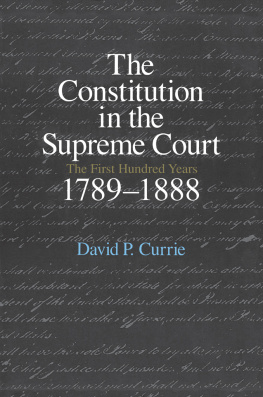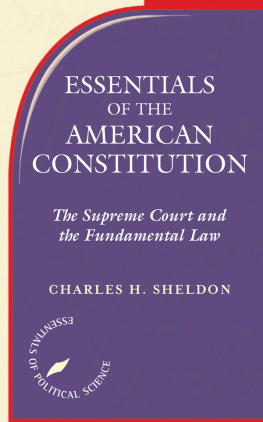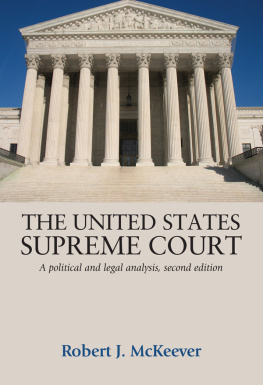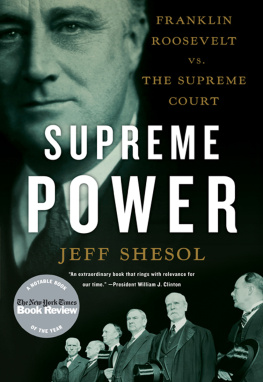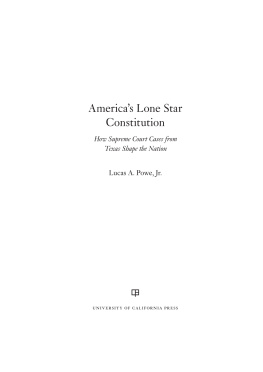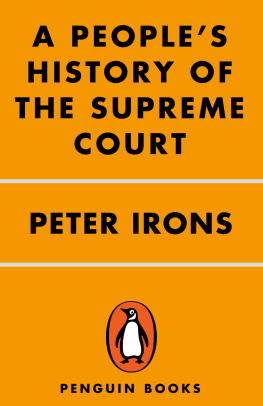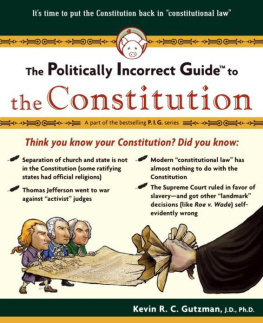The University of Chicago Press, Chicago 60637
The University of Chicago Press, Ltd., London
1985 by The University of Chicago
All rights reserved. Published 1985
Paperback edition 1992
Printed in the United States of America
06 05 04 03 02 01 00 99 98 97 4 5 6 7 8
ISBN: 978-0-226-22242-4 (ebook)
Library of Congress Cataloging in Publication Data
Currie, David P.
The constitution in the Supreme Court
Includes index.
1. United StatesConstitutional lawInterpretation and construction. 2. United States. Supreme Court. 3. United StatesConstitutional history. I. Title.
KF4550.C87 1985 342.73 85-1205
ISBN: 0-226-13109-2 (paperback)
347.302

The paper used in this publication meets the minimum requirements of the American National Standard for Information SciencesPermanence of Paper for Printed Library Materials, ANSI Z39.48-1992.
The Constitution in the Supreme Court
The First Hundred Years 17891888
David P. Currie
University of Chicago Press
Chicago and London
Introduction
Histories of the Supreme Court and of the Constitution abound, as do legal analyses of constitutional decisions. The histories, however, tend to eschew legal criticism, while the analyses tend to be organized by subject matter. My aim is to provide a critical history, analyzing from a lawyers standpoint the entire constitutional work of the Courts first hundred years. My search is for methods of constitutional analysis, for techniques of opinion writing, for the quality of the performances of the Court and of its members.
Standards of judicial performance not only change over time;the course of discussing the opinions, it may be well to state some of them explicitly at the start.
I begin with the conviction that the Constitution is a law binding the judges no less than the other officials whose actions the courts undertake to review. That is what the Constitution itself says,
Since the Constitution is law, the judges have no right to ignore constitutional limitations with which they disagree. Moreover, the same clause that makes the Constitution the Law of the Land gives identical status to federal statutes enacted in Pursuance thereof. Whatever this may signify as to the status of laws that contradict the Constitution,
This is not to say that either the text of the Constitution or the limited additional evidence we have of the Framers intentions answers every question of constitutional interpretation. It is not to pretend that the Framers either thought out all the ramifications of their terminology or would have agreed in all particulars if they had. Nor is it to deny the possibility that one provision or another may have been meant to in any case in which the latter can fairly be ascertained.
Beyond this, I share the conventional views that judges have an obligation to explain the reasons for their decisions as concisely and persuasively as practicable, and that they should strive for consistency, reserving the right to correct egregious and important errors on relatively rare occasions. I shall not stop to justify these convictions. As a colleague of mine recently remarked, [s]cholars who spend too much time debating how to conduct a discourse may never be able to say anything at all. My aim is not to defend the rule of law but to apply its methodology to the cases.
Part One
Chief Justices Jay and Ellsworth 17891801
Introduction to Part One
The accomplishments of the Supreme Court during the long period when John Marshall was Chief Justice were so great that the modest record of his predecessors tends to be overlooked. The relative paucity of early federal legislation, the absence of a general grant of original federal jurisdiction over cases arising under federal law, and the fact that the Courts jurisdiction was largely appellate contributed to a low starting caseload. Yet for all this the twelve years before Marshalls appointment proved to be a significant formative period during which the Justices established traditions of constitutional interpretation that were to influence the entire future course of decision.
The first Chief Justice was John Jay; his associates were John Rutledge, William Cushing, James Wilson, John Blair, and James Iredell. Of the original appointees only Cushing remained in 1801. Jay was replaced by Oliver Ellsworth, his brethren by Thomas Johnson, Samuel Chase, Bushrod Washington, and Alfred Moore. Johnson in turn was replaced by William Paterson.
Johnson departed before any significant opinions were written; Ellsworth sat in none of the cases that produced real opinions; Washington and Moore belong to the Marshall period. As far as the written word is concerned, we therefore are studying seven men: Jay, Cushing, Wilson, Blair, Iredell, Paterson, and Chase.
The Supreme Court published full-scale opinions construing the Constitution in only three cases before 1801. Chisholm v. Georgia that a state legislature had not passed a forbidden ex post facto law when it set aside a judicial decree in a will contest.
These three controversies, however, do not exhaust the pre-Marshall Courts encounters with matters constitutional. In Ware v. Hylton,
Outlines of Federal Jurisdiction
Because jurisdiction is a threshold issue in every federal case, the Court would settle in its first forty years many of the fundamental issues surrounding the federal judicial power. A significant start was made in the cases decided before Marshall. These decisions are the subject of this chapter; the remaining pre-Marshall decisions are considered in the next.
I. CASES AND CONTROVERSIES
A. Hayburns Case
In 1792, Congress authorized pensions for disabled war veterans. The statute required applicants to file proofs with the circuit court, which, if it found the applicant eligible, was to certify its finding to the Secretary at War.
William Hayburn filed for a pension under this statute, and the Circuit Court for the District of Pennsylvania refused to entertain his application. Although the judges apparently wrote no opinion, they took the unusual step of explaining their refusal in a letter to President Washington. Two other circuits
Attorney General Edmund Randolph then asked the Supreme Court for a writ of mandamus compelling the circuit court to pass upon Hayburns petition. An examination on the merits would have required the Court to decide whether the statute conferred either nonjudicial power on the courts or judicial power on the Secretary of War, and if so, whether negative implications should be drawn from the provision of article III stating that the judicial Power... shall be vested in... Courts.
The Court seems to have taken for granted, as it since has held,that the Justices stopped to explain that they had the power or duty to raise such issues, or whence it was derived.
Nor does the report reveal the Justices reasons for concluding that the Attorney General lacked authority to proceed ex officio. Indeed, we must turn to the newspapers to find that the vote was 33,
None of these conclusions is obvious, and it is by no means clear that the Justices meant to invoke what we now know as the constitutional dimension of the law of standing to sue. It is conceivable that they gave a narrow reading to section 35 of the Judiciary Act,
In short, the reported disposition of this first constitutional controversy in the Supreme Court was inconclusive. We know the Court left the validity of executive revision of court decisions for another day, but we cannot say whether the three
 The paper used in this publication meets the minimum requirements of the American National Standard for Information SciencesPermanence of Paper for Printed Library Materials, ANSI Z39.48-1992.
The paper used in this publication meets the minimum requirements of the American National Standard for Information SciencesPermanence of Paper for Printed Library Materials, ANSI Z39.48-1992.
